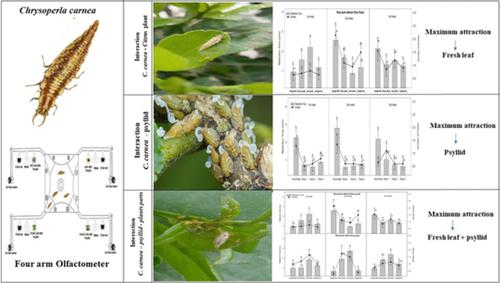当前位置:
X-MOL 学术
›
Agric. For. Entomol.
›
论文详情
Our official English website, www.x-mol.net, welcomes your
feedback! (Note: you will need to create a separate account there.)
Synergistic impact of semiochemicals of plant parts and prey on chemotaxis response of Chrysoperla carnea
Agricultural and Forest Entomology ( IF 1.6 ) Pub Date : 2022-02-21 , DOI: 10.1111/afe.12495 Muhammad Shah Zaib 1 , Khalid Abbas 1 , Muhammad Zakria 1 , Syed Muhammad Zaka 1
中文翻译:

植物部位和猎物的化学信息素对金虾趋化反应的协同影响
更新日期:2022-02-21
Agricultural and Forest Entomology ( IF 1.6 ) Pub Date : 2022-02-21 , DOI: 10.1111/afe.12495 Muhammad Shah Zaib 1 , Khalid Abbas 1 , Muhammad Zakria 1 , Syed Muhammad Zaka 1
Affiliation

|
- Diaphorina citri is a major pest of citrus tress because it is the vector of citrus greening. Growers rely on insecticides to manage D. citri, but these have side effects (e.g., pollution, public health issues, pest resistance, etc.). There is a need to assess the role of semiochemicals in the biological control of D. citri.
- A four-armed olfactometer was used to evaluate the orientation response of larval Chrysoperla carnea, a natural enemy, to odours produced by young leaves, mature leaves, ripe fruit and fruit peel of mandarine orange (Citrus reticulata). Lacewing responses to both uninfested plant parts and infested with D. citri were measured.
- Results showed that C. carnea discriminated between the volatiles emitted by plant parts and citrus psyllid. In all tested combinations (I-V), both in the absence and presence of citrus psyllid, all first, second and three C. carnea preferred the volatiles of fresh leaves and old leaves over other plant parts. Moreover, all three instars of the predator significantly preferred the area having volatile of citrus psyllid.
- Volatiles of fresh leaves and old leaves can be used in the management of citrus psyllid. Moreover, this tritrophic interaction could play a vital role in developing IPM strategies for the management of citrus psylla.
中文翻译:

植物部位和猎物的化学信息素对金虾趋化反应的协同影响
- Diaphorina citri是柑橘树的主要害虫,因为它是柑橘绿化的载体。种植者依靠杀虫剂来管理D. citri,但这些都有副作用(例如,污染、公共卫生问题、害虫抗性等)。有必要评估化学信息素在柑橘 D. citri生物防治中的作用。
- 使用四臂嗅觉仪来评估幼虫Chrysoperla carnea(一种天敌)对橘子(Citrus reticulata)幼叶、成熟叶、成熟果实和果皮产生的气味的定向反应。测量了草蛉对未受侵染的植物部分和被D. citri侵染的响应。
- 结果表明,C. carnea可区分植物部分和柑橘木虱释放的挥发物。在所有测试的组合 (IV) 中,在柑橘木虱不存在和存在的情况下,所有第一、第二和三个C. carnea 都比其他植物部分更喜欢新鲜叶和老叶的挥发物。此外,捕食者的所有三龄都明显偏爱具有挥发性柑橘木虱的区域。
- 鲜叶和老叶的挥发物可用于柑橘木虱的管理。此外,这种三营养相互作用可以在制定 IPM 策略以管理柑橘木虱方面发挥重要作用。











































 京公网安备 11010802027423号
京公网安备 11010802027423号